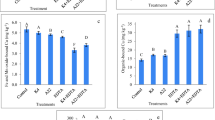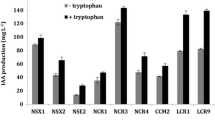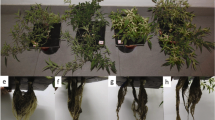Abstract
Background and aims
This study aims at identifying Cu accumulators from Elsholtzia and uncovering the rhizospheric mechanisms for improving the phytoremediation of Cu-contaminated soils.
Methods
The Cu accumulation capacities of ten Elsholtzia species were investigated in Cu-polluted soil, and two species with the largest differences in Cu accumulation capacities were selected to verify the results and to analyze their rhizospheric response characteristics (e.g., changes in Cu availability and rhizospheric bacterial community) to Cu stress in soils spiked with 0, 250, and 500 mg kg−1 Cu.
Results
These 10 Elsholtzia species showed various Cu accumulation capacities (Cu bioconcentration factors: 0.55–1.86 in shoots, 1.13–5.27 in roots), and most of them showed the potential for Cu phytostabilization. Among them, E. eriocalyx and E. winitiana could both tolerate up to 500 mg kg−1 Cu in soils but showed high- and low-Cu-accumulating capacities, respectively. Rhizospheric analysis indicated that specific rhizobacteria recruited by E. eriocalyx and E. winitiana were responsible for their differential Cu uptake. Several different plant growth-promoting rhizobacteria (e.g., Sphingomonas, Gemmatimonas, Devosia, and Flavisolibacter) might contribute to the plant vitality of E. eriocalyx under Cu stress. Moreover, the dominant Sphingomonas was responsible for the higher Cu accumulation in E. eriocalyx plants. However, the dominance of several rhizobacteria in the Planctomycetes phylum might participate in Cu immobilization, thus decreasing Cu uptake by E. winitian.
Conclusion
This study identifies novel Elsholtzia species resources for the phytoremediation of Cu-contaminated soils and improves our understanding of the roles of rhizobacteria in regulating the Cu accumulation capacities of plants.




Similar content being viewed by others
Data availability
The datasets generated and/or analyzed during the current study are available from the corresponding author on reasonable request.
References
Alves ARA, Yin Q, Oliveira RS, Silva EF, Novo LAB (2022) Plant growth-promoting bacteria in phytoremediation of metal-polluted soils: current knowledge and future directions. Sci Total Environ 838:156435. https://doi.org/10.1016/j.scitotenv.2022.156435
Asaf S, Numan M, Khan AL, Al-Harrasi A (2020) Sphingomonas: from diversity and genomics to functional role in environmental remediation and plant growth. Crit Rev Biotechnol 40:138–152. https://doi.org/10.1080/07388551.2019.1709793
Borden KA, Mafa-Attoye TG, Dunfield KE, Thevathasan NV, Gordon AM, Isaac ME (2021) Root functional trait and soil microbial coordination: implications for soil respiration in riparian agroecosystems. Front Plant Sci 12:681113. https://doi.org/10.3389/fpls.2021.681113
Chen YX, Wang YP, Lin Q, Luo YM (2005) Effect of copper-tolerant rhizosphere bacteria on mobility of copper in soil and copper accumulation by Elsholtzia splendens. Environ Int 31:861–866. https://doi.org/10.1016/j.envint.2005.05.044
Chen ZJ, Tian W, Li YJ, Sun LN, Chen Y, Zhang H, Li YY, Han H (2021) Responses of rhizosphere bacterial communities, their functions and their network interactions to Cd stress under phytostabilization by Miscanthus spp. Environ Pollut 287:117663
Cheraghi M, Lorestani B, Khorasani N, Yousefi N, Karami M (2011) Findings on the phytoextraction and phytostabilization of soils contaminated with heavy metals. Biol Trace Elem Res 144:1133–1141. https://doi.org/10.1007/s12011-009-8359-0
Chhetri G, Kim I, Kang MC, Kim J, So Y, Seo T (2022) Devosia rhizoryzae sp. nov., and Devosia oryziradicis sp. nov., novel plant growth promoting members of the genus Devosia, isolated from the rhizosphere of rice plants. J Microbiol 60:1–10. https://doi.org/10.1007/s12275-022-1474-8
Duan C, Wang Y, Wang Q, Ju W, Zhang Z, Cui Y, Beiyuan J, Fan Q, Wei S, Li S, Fang L (2022) Microbial metabolic limitation of rhizosphere under heavy metal stress: evidence from soil ecoenzymatic stoichiometry. Environ Pollut 300:118978. https://doi.org/10.1016/j.envpol.2022.118978
Frossard A, Hartmann M, Frey B (2017) Tolerance of the forest soil microbiome to increasing mercury concentrations. Soil Biol Biochem 105:162–176. https://doi.org/10.1016/j.soilbio.2016.11.016
Guo JK, Muhammad H, Lv X, Wei T, Ren XH, Jia HL, Atif S, Hua L (2020) Prospects and applications of plant growth promoting rhizobacteria to mitigate soil metal contamination: a review. Chemosphere 246:125823. https://doi.org/10.1016/j.chemosphere.2020.125823
Hesse E, O'Brien S, Tromas N, Bayer F, Lujan AM, van Veen EM, Hodgson DJ, Buckling A (2018) Ecological selection of siderophore-producing microbial taxa in response to heavy metal contamination. Ecol Lett 21:117–127. https://doi.org/10.1111/ele.12878
Jing WJ, Quan ZJ, Han Y, Cai X, Ma JY (2022) Research progress of rhizosphere effect in the remediation of heavy metal contaminated soil. J Environ Eng Technol 12:153–160
Kumar V, Pandita S, Sidhu GPS, Sharma A, Khanna K, Kaur P, Bali AS, Setia R (2021) Copper bioavailability, uptake, toxicity and tolerance in plants: a comprehensive review. Chemosphere 262:127810. https://doi.org/10.1016/j.chemosphere.2020.127810
Li JT, Gurajala HK, Wu LH, van der Ent A, Qiu RL, Baker AJM, Tang YT, Yang XE, Shu WS (2018) Hyperaccumulator plants from China: a synthesis of the current state of knowledge. Environ Sci Technol 52:11980–11994. https://doi.org/10.1021/acs.est.8b01060
Li X, Chen D, Li BQ, Yang YP (2021a) Cd accumulation characteristics of Salvia tiliifolia and changes of rhizospheric soil enzyme activities and bacterial communities under a Cd concentration gradient. Plant Soil 463:225–247. https://doi.org/10.1007/s11104-021-04905-0
Li X, Li BQ, Zheng Y, Luo LD, Qin XS, Yang YP, Xu JC (2022) Physiological and rhizospheric response characteristics to cadmium of a newly identified cadmium accumulator Coreopsis grandiflora Hogg. (Asteraceae). Ecotox Environ Safe 241:113739. https://doi.org/10.1016/j.ecoenv.2022.113739
Li X, Li XF, Li YY, Dai XZ, Zhang QZ, Zhang M, Zhang ZQ, Tao Y, Chen WC, Zhang MX, Zhou XY, Yang S, Ma YQ, Zhran M, Zou XX (2021b) Improved immobilization of soil cadmium by regulating soil characteristics and microbial community through reductive soil disinfestation. Sci Total Environ 778:146222. https://doi.org/10.1016/j.scitotenv.2021.146222
Li X, Yang YP (2020) Preliminary study on Cd accumulation characteristics in Sansevieria trifasciata Prain. Plant Divers 42:351–355. https://doi.org/10.1016/j.pld.2020.05.001
Lin H, Liu CJ, Li B, Dong YB (2021) Trifolium repens L. regulated phytoremediation of heavy metal contaminated soil by promoting soil enzyme activities and beneficial rhizosphere associated microorganisms. J Hazard Mater 402:123829. https://doi.org/10.1016/j.jhazmat.2020.123829
Madline A, Benidire L, Boularbah A (2021) Alleviation of salinity and metal stress using plant growth-promoting rhizobacteria isolated from semiarid Moroccan copper-mine soils. Environ Sci Pollut R 28:67185–67202. https://doi.org/10.1007/s11356-021-15168-8
Manoj SR, Karthik C, Kadirvelu K, Arulselvi PI, Shanmugasundaram T, Bruno B, Rajkumar M et al (2020) Understanding the molecular mechanisms for the enhanced phytoremediation of heavy metals through plant growth promoting rhizobacteria: a review. J Environ Manag 254:109779. https://doi.org/10.1016/j.jenvman.2019.109779
Massenet A, Bonet A, Laur J, Labrecque M (2021) Co-planting Brassica napus and Salix nigra as a phytomanagement alternative for copper contaminated soil. Chemosphere 279:130517. https://doi.org/10.1016/j.chemosphere.2021.130517
Ming HZ, Fan JF, Liu JW, Su J, Wan ZY, Wang YT, Li DW, Li MF, Shi TT, Jin Y, Huang HL, Song JX (2021) Full-length 16S rRNA gene sequencing reveals spatiotemporal dynamics of bacterial community in a heavily polluted estuary. China Environ Pollut 275:116567. https://doi.org/10.1016/j.envpol.2021.116567
Mo SQ, Cao YN, Tan Q (2022) Research progress on root exudates and their effects on ecological remediation of heavy metal contaminated soil. Chinese J Ecol 41:382–392
Perez R, Tapia Y, Antilen M, Casanova M, Vidal C, Silambarasan S, Cornejo P (2021) Rhizosphere management for phytoremediation of copper mine tailings. J Soil Sci Plant Nut 21:3091–3109. https://doi.org/10.1007/s42729-021-00591-0
Rajkumar M, Ae N, Prasad MNV, Freitas H (2010) Potential of siderophore-producing bacteria for improving heavy metal phytoextraction. Trends Biotechnol 28:142–149. https://doi.org/10.1016/j.tibtech.2009.12.002
Rakic T, Pesic M, Kostic N, Andrejic G, Fira D, Dzeletovic Z, Stankovic S, Lozo J (2021) Rhizobacteria associated with Miscanthus x giganteus improve metal accumulation and plant growth in the flotation tailings. Plant Soil 462:349–363. https://doi.org/10.1007/s11104-021-04865-5
Reeves RD, Baker AJM, Jaffre T, Erskine PD, Echevarria G, van der Ent A (2018) A global database for plants that hyperaccumulate metal and metalloid trace elements. New Phytol 218:407–411. https://doi.org/10.1111/nph.14907
Salmi A, Boulila F (2021) Heavy metals multi-tolerant Bradyrhizobium isolated from mercury mining region in Algeria. J Environ Manag 289:112547. https://doi.org/10.1016/j.jenvman.2021.112547
Sun LN, He LY, Zhang YF, Zhang WH, Wang Q, Sheng XF (2009) Isolation and biodiversity of copper-resistant bacteria from rhizosphere soil of Elsholtzia splendens. Acta Microbiol Sinica 49:1360–1366
Uriu-Adams JY, Keen CL (2005) Copper, oxidative stress, and human health. Mol Asp Med 26:268–298. https://doi.org/10.1016/j.mam.2005.07.015
Wang CC, Zhang QC, Kang SG, Li MY, Zhang MY, Xu WM, Xiang P, Ma LQ (2023) Heavy metal(loid)s in agricultural soil from main grain production regions of China: bioaccessibility and health risks to humans. Sci Total Environ 858:159819. https://doi.org/10.1016/j.scitotenv.2022.159819
Wang FY, Lin XG, Yin R (2007) Role of microbial inoculation and chitosan in phytoextraction of Cu, Zn, Pb and Cd by Elsholtzia splendens-a field case. Environ Pollut 147:248–255. https://doi.org/10.1016/j.envpol.2006.08.005
Wang M, Li SS, Li XY, Zhao ZQ, Chen SB (2018a) An overview of current status of copper pollution in soil and remediation efforts in China. Earth Sci Front 25:305–313
Wang N, Wen QZ, Shu FF, Mao WL, Wang SL, Chen HB, Deng JH, Yang S, Li YD (2018b) Regulation effect of hoof horn powder and its hydrolyzed polypeptide on form of Cu2+ in polluted soil. Chinese J Environ Eng 12:2910–2916
Wang RZ, Hou DD, Chen JZ, Li JH, Fu YY, Wang S, Zheng W, Lu LL, Tian SK (2020) Distinct rhizobacterial functional assemblies assist two Sedum alfredii ecotypes to adopt different survival strategies under lead stress. Environ Int 143:105912
Yang J, Huang Y, Zhao G, Li B, Qin X, Xu J, Li X (2022) Phytoremediation potential evaluation of three rhubarb species and comparative analysis of their rhizosphere characteristics in a Cd- and Pb-contaminated soil. Chemosphere 296:134045. https://doi.org/10.1016/j.chemosphere.2022.134045
York LM, Carminati A, Mooney SJ, Ritz K, Bennett MJ (2016) The holistic rhizosphere: integrating zones, processes, and semantics in the soil influenced by roots. J Exp Bot 67:3629–3643. https://doi.org/10.1093/jxb/erw108
Zeng XY, Li SW, Leng Y, Kang XH (2020) Structural and functional responses of bacterial and fungal communities to multiple heavy metal exposure in arid loess. Sci Total Environ 723:138081. https://doi.org/10.1016/j.scitotenv.2020.138081
Acknowledgments
We are grateful to the Germplasm Bank of Wild Species of China for providing the seeds.
Funding
This work was funded by the Youth Innovation Promotion Association CAS (2020387) and the Honghe Agroforestry Ecological Research Station of Yunnan Province (202205AM070007).
Author information
Authors and Affiliations
Contributions
Xiong Li contributed to the study conception and design. Material preparation, data collection and analysis were performed by Xiong Li, Gaojuan Zhao, Yingqi Huang and Boqun Li. The first draft of the manuscript was written by Xiong Li and all authors commented on previous versions of the manuscript. All authors read and approved the final manuscript.
Corresponding author
Ethics declarations
Competing interests
The authors declare that they have no known competing financial interests or personal relationships that could have appeared to influence the work reported in this paper.
Additional information
Responsible Editor: Juan Barcelo.
Publisher’s note
Springer Nature remains neutral with regard to jurisdictional claims in published maps and institutional affiliations.
Supplementary Information
Rights and permissions
Springer Nature or its licensor (e.g. a society or other partner) holds exclusive rights to this article under a publishing agreement with the author(s) or other rightsholder(s); author self-archiving of the accepted manuscript version of this article is solely governed by the terms of such publishing agreement and applicable law.
About this article
Cite this article
Li, X., Zhao, G., Huang, Y. et al. Distinct rhizobacteria recruitment under copper stress contributes to the different copper-accumulating capacities of two Elsholtzia species (Lamiaceae). Plant Soil 489, 295–307 (2023). https://doi.org/10.1007/s11104-023-06017-3
Received:
Accepted:
Published:
Issue Date:
DOI: https://doi.org/10.1007/s11104-023-06017-3




